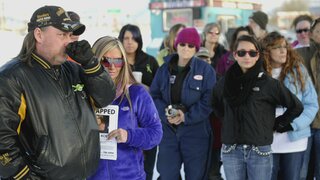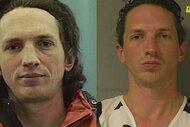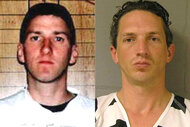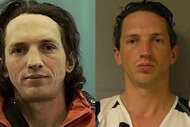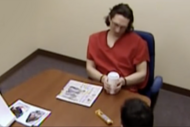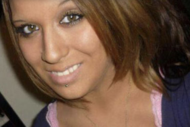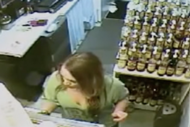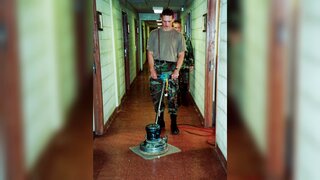Create a free profile to get unlimited access to exclusive videos, breaking news, sweepstakes, and more!
Alaskan Serial Killer Israel Keyes: Murder Kits, Mind Games And Mysterious Crimes
Israel Keyes ultimately claimed to have killed up to 11 victims between 2001 and 2012, but couldn’t — or wouldn’t — tell authorities exactly when and where.
Murders A-Z is a collection of true crime stories that take an in-depth look at both little-known and infamous murders throughout history.
Among serial killers, Israel Keyes is an enigma. When police picked him up in Texas in March of 2012, it was for the murder of 18-year-old Samantha Koenig, whom he had brazenly kidnapped from a coffee stand in Anchorage, Alaska. Once in custody, however, he confessed to other murders and bank robberies and alluded to many more crimes. He ultimately claimed to have killed up to 11 victims between 2001 and 2012, but couldn’t — or wouldn’t — tell the authorities exactly when and where. He told them enough, however, for them to take him seriously. Then, in December 2012, after nine months in custody, he killed himself, taking his secrets with him to the grave.
Who Is Israel Keyes?
Born in Richmond, Utah, on January 7, 1978, Israel Keyes was the second-youngest of 10 siblings. His parents were Mormons who later became strict fundamentalist Christians that homeschooled their children and moved them around frequently. While living in Colville, Washington, the family attended a racist Christian Identity church, where, according to Salon, he befriended future white supremacist terrorists and murderers Chevie and Cheyne Kehoe, who were also his neighbors.
Keyes would later tell investigators he was obsessed with guns as a boy, and began to hunt "anything with a heartbeat." As a teenager, he would break into people’s homes and steal their firearms. He started to reject the Christian faith and flirted with Satanism, leading to a schism with his parents.
Keyes first crimes occurred during the summer of 1997, when he claimed he kidnapped and raped a teenage girl near the Deschutes River in Oregon, according to KTVZ. He lived in the nearby town of Maupin, and said he lured the girl away from her friends while she was inner tubing on the river. Keyes let the girl go after sexually assaulting her, and the crime was never reported.
When Keyes was 20 years old, he got a high school equivalency degree and joined the US Army. Over the next two years, he was stationed in Washington State, Texas and Egypt. He made friends in the Army, though friend Searn McGuire claimed he had a dark side and drank heavily. He was honorably discharged in 2001.
While stationed at Washington’s Fort Lewis Army base, Keyes began a relationship with a woman who was a member of the Makah Indian Tribe. She later gave birth to his daughter. After his discharge from the Army, they would move to the Makah Reservation in Neah Bay, Washington, where Keyes worked for the tribal authority. He intimated to investigators that he committed his first murder soon after moving there in 2001, because, "Neah Bay's a boring town."
How Many People Did Israel Keyes Kill?
Keyes would later claim he committed four murders while living in Washington, though these crimes remain unconfirmed and the identities of his alleged victims are unknown. He said one of his victims was bludgeoned to death, while another was dumped in nearby Lake Crescent. An FBI press release from 2013, which sought the public’s assistance in substantiating his claims, stated that Keyes admitted killing, “an unidentified couple in Washington,” but his details ended there. “It is unknown if the victims were residents of Washington, tourists, or residents he abducted from a nearby state and transported to Washington.”
In March 2007, Keyes and his daughter moved to Anchorage, Alaska, to live with a woman he was dating. He worked as a handyman and contractor, and started his own business, Keyes Construction. He also visited various family members throughout the country and traveled internationally. The FBI determined he took as many as 35 trips between October 2004 and his capture in March 2012, and fear he claimed victims throughout his travels.
Unlike other serial killers, Keyes had no victim type, killing both men and women of various ages, though he would later claim children and parents were off limits. To avoid any connections, he targeted total strangers, traveling thousands of miles to stalk his victims and learn their habits before killing them. He funded these expeditions by robbing banks, including the April 2009 robbery of a bank in Tupper Lake, New York, 70 miles south of property he owned in the town of Constable. Keyes stashed “murder kits” near future crimes scenes around the country that contained weapons and supplies to dispose of his victims' bodies. He would later tell investigators his preferred murder method was strangulation, so he could watch his victims suffer.
Among the crimes law enforcement believes Keyes may be connected to is the disappearance of 49-year-old Debra Feldman, who was last seen at her home in Hackensack, New Jersey, on April 8, 2009. After his arrest for the Koenig murder, Keyes told investigators he abducted a woman on the East Coast on April 9, 2009, and transported her to upstate New York, where he murdered and buried her.
FBI Special Agent Barbara Woodruff would later tell CNN that when Keyes was shown a picture of Feldman, he paused and said, "I'm not ready to talk about that one."
There has also been substantial internet chatter about the possibility of Keyes being involved with the 2004 disappearance of 21-year-old nursing student Maura Murray, who went missing after crashing her car in Northern New Hampshire. Police, however, have denied any connection between the two crimes.
In early June 2011, Keyes flew from Alaska to Chicago, then rented a car and drove to Essex, Vermont, to look for victims. He had previously buried a murder kit nearby during a visit to the area in 2009, and he later told investigators he was looking for a house with an attached garage, no cars in the driveway, with no children and no dogs. Finally, after several days, he set his sights on Bill Currier, 50, and his wife Lorraine, 55.
On the night of June 8, 2011, Keyes broke into the Curriers' home, rushed to their bedroom and within seconds had restrained them with zip ties. He then loaded them into their own car and drove them to a farmhouse he had previously scouted where he planned to kill them. There, Lorraine Currier tried to make a break for it, but she was tackled and taken inside. When Bill Currier attempted to break free and rescue his wife, Keyes hit him in the head with a shovel and shot him. He then sexually assaulted Lorraine before strangling her. He claims he put their bodies in garbage bags and covered them with debris. The house was later demolished, and the couple’s remains have never been found. He dumped the gun in a reservoir in Parishville, New York, where it was eventually recovered by an FBI dive team.
Keyes' most brazen crime was also the one that brought him down. On February 1, 2012, he kidnapped barista Samantha Koenig, 18, from the Common Grounds Espresso in Anchorage at gun point. He initially told her he was going to hold her for ransom, but after retrieving her cell phone and ATM card, he took her to a shed on his property where he sexually assaulted her and strangled her to death. The following day, he left for a two-week cruise that departed from New Orleans. Afterwards, he rented a car and drove through Texas, where he robbed a bank, set a home on fire and (police suspect) killed another victim.
How Was Israel Keyes Caught?
Upon returning to Anchorage on February 17, Keyes sent a photograph where it appeared Koenig was still alive, and demanded $30,000 ransom be placed in her bank account. Afterwards, he dismembered her body and disposed of it in Matanuska Lake, north of Anchorage. Keyes once more hit the road, traveling to Arizona, through New Mexico, before hitting Texas again, using Koenig’s ATM card to make withdrawals all the way. Police were able to track his movements, and on March 13, 2012, he was apprehended in the parking lot of a Cotton Patch Café in Lufkin, Texas.
Sometime after being extradited to Alaska, Keyes began talking, giving the FBI details of his crimes in bits and pieces.
"There is no one who knows me, or who has ever known me, who knows anything about me, really,” he told investigators. “They’re going to tell you something that does not line up with anything I tell you, because I’m two different people, basically.”
Keyes was eventually forthcoming with details about the Currier and Koenig murders, but he held back from giving exact details of his other crimes.
He was worried about the effect it would have on his daughter, saying, “I want her to have a chance to grow up and not have all of this hanging over her head."
He would ultimately give 40 hours’ worth of interviews to investigators, but he never divulged the names of his other victims or dates of their murders.
Keyes said he had studied the methods of fellow serial killer Ted Bundy, whom he admired, but called BTK Killer Dennis Rader a “wimp,” for professing remorse for his killings after he was caught, according to the Anchorage Daily News. When asked why he committed his crimes, he reportedly replied, “Why not?”
Regarding Keyes and killing, FBI Special Agent Jolene Goeden said: "He enjoyed it. He liked what he was doing."
"My whole issue is to keep control of it," Keyes had told investigators as they pressed him for details.
How Did Israel Keyes Die?
On the night of December 1, 2012, Keyes took more control of his narrative, committing suicide with a piece of a razor he had hidden in a pencil and using bedding material to strangle himself. Despite being previously held in a “suicide cell,” his suicide went undetected until the following morning. Following his death, the FBI went public with information about his possible connection to multiple unsolved murders and appealed for people to come forward with information. To date, Keyes' other alleged murders and crimes have yet to be confirmed.
On December 10, 2012, Keyes' mother Heidi and four of his sisters convened in Deer Park, Washington, about an hour south of Coleville where Israel grew up, for a small funeral service. They brought with them their pastor, Jake Gardner of The Church Of Wells, from Wells, Texas, where most of Keyes family now lives.
“He is not in a better place,” Gardner said before the service began. “He’s in a place of eternal torment.”
(This story was originally published on October 24, 2018 and has since been updated with more information.)



